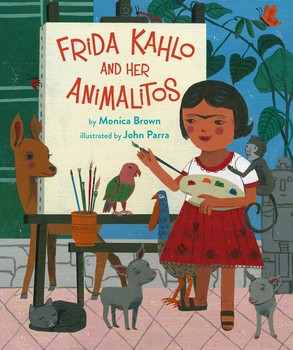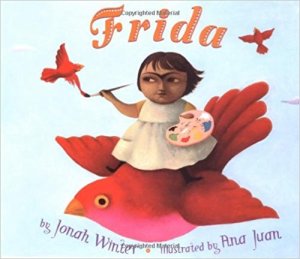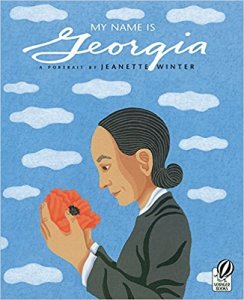 What is your state of mind right now? Festive . . . as you think of upcoming winter holidays? Fearful . . . as you contemplate current political events and crises? Or are you calm and content because you enjoy a few minutes with book “news” such as this?
What is your state of mind right now? Festive . . . as you think of upcoming winter holidays? Fearful . . . as you contemplate current political events and crises? Or are you calm and content because you enjoy a few minutes with book “news” such as this?
My mind recently has been in another state—literally as well as figuratively. I spent the first part of October in New Mexico  and jelled some of my thoughts about that visit in an article posted here the other week. So when I learned that some of this year’s best book lists featured sights and authors I had encountered in New Mexico I let that coincidence shape today’s Gone Graphic. Here are some great new (as well as a few older) picture books for you to enjoy and share with the young people in your life. All have that Southwestern connection.
and jelled some of my thoughts about that visit in an article posted here the other week. So when I learned that some of this year’s best book lists featured sights and authors I had encountered in New Mexico I let that coincidence shape today’s Gone Graphic. Here are some great new (as well as a few older) picture books for you to enjoy and share with the young people in your life. All have that Southwestern connection.
 Frida Kahlo and her Animalitos (2017), written by Monica Brown and illustrated by John Parra, is a wonderful addition to works about that Mexican painter. Its vivid acrylic colors and flat, folk art style—typical of the tradition to which world-renowned Kahlo (1907 – 1954) brought her own vision—won this book two awards. It is on both the New York Times and New York Public Library’s 2017 Best Illustrated Books for Children lists. Brown’s gentle text communicates the facts of Kahlo’s life, including how important pets were to her, while Parra’s cheerful illustrations convey how these creatures inspired her. Some of Animalito’s first pages, though, show young Frida with pets she famously had only as an adult, which surprised me. Brown in her Author’s Note explains her debatable decision to emphasize insight into Kahlo’s spirit over the purely factual.
Frida Kahlo and her Animalitos (2017), written by Monica Brown and illustrated by John Parra, is a wonderful addition to works about that Mexican painter. Its vivid acrylic colors and flat, folk art style—typical of the tradition to which world-renowned Kahlo (1907 – 1954) brought her own vision—won this book two awards. It is on both the New York Times and New York Public Library’s 2017 Best Illustrated Books for Children lists. Brown’s gentle text communicates the facts of Kahlo’s life, including how important pets were to her, while Parra’s cheerful illustrations convey how these creatures inspired her. Some of Animalito’s first pages, though, show young Frida with pets she famously had only as an adult, which surprised me. Brown in her Author’s Note explains her debatable decision to emphasize insight into Kahlo’s spirit over the purely factual.
 While I was in Santa Fe, its Museum of Spanish Colonial Art hosted a photography exhibit about Frida Kahlo as well as a gallery of works inspired by her paintings. Along with Animalitos, its gift shop offered young readers the sumptuous Frida (2002), written by Jonah Winters and illustrated by Ana Juan. Winters’ text is simpler than Brown’s and does not
While I was in Santa Fe, its Museum of Spanish Colonial Art hosted a photography exhibit about Frida Kahlo as well as a gallery of works inspired by her paintings. Along with Animalitos, its gift shop offered young readers the sumptuous Frida (2002), written by Jonah Winters and illustrated by Ana Juan. Winters’ text is simpler than Brown’s and does not  mention Frida Kahlo’s troubled marriage to artist Diego Rivera, alluded to in Animalitos. Yet Frida is appropriate for young readers or listeners and is a visual treasure trove for all ages. It is filled with Mexican folk motifs found in many of Kahlo’s own paintings—including the skeletal images detailed so well by author/illustrator Duncan Tonitiuh in his award-winning Funny Bones: Posada and his Day of the Dead Calaveras (2015), reviewed here last year.
mention Frida Kahlo’s troubled marriage to artist Diego Rivera, alluded to in Animalitos. Yet Frida is appropriate for young readers or listeners and is a visual treasure trove for all ages. It is filled with Mexican folk motifs found in many of Kahlo’s own paintings—including the skeletal images detailed so well by author/illustrator Duncan Tonitiuh in his award-winning Funny Bones: Posada and his Day of the Dead Calaveras (2015), reviewed here last year.
Other Santa Fe museum visits also yielded picture book treasures. Gift shops associated with the Georgia O’Keefe Museum and that artist’s studio-home in nearby Abiquiu introduced me to author/illustrator Jeanette Winter’s My Name is  Georgia: A Portrait (1998; 2003). I preferred Winter’s deft first-person text, sometimes using quotations from O’Keefe herself, over the ‘storytelling’ done in two other picture book biographies also for sale there. With images extending past the borders of each page’s centered image, Winters intimately depicts O’Keefe’s life-long journey from Wisconsin to the Texas plains, to New York City and then to the New Mexico landscapes she found so imaginatively fertile. I had delighted in Winters dual biography of two real-life heroes, Malala: A Brave Girl from Pakistan/Iqbal: A Brave Boy from Pakistan (2014), and her award-winning Nasreen’s Secret School: A True Story from Afganistan (2009), both reviewed here last year, but I had not caught up with her back list of books about famous artists.
Georgia: A Portrait (1998; 2003). I preferred Winter’s deft first-person text, sometimes using quotations from O’Keefe herself, over the ‘storytelling’ done in two other picture book biographies also for sale there. With images extending past the borders of each page’s centered image, Winters intimately depicts O’Keefe’s life-long journey from Wisconsin to the Texas plains, to New York City and then to the New Mexico landscapes she found so imaginatively fertile. I had delighted in Winters dual biography of two real-life heroes, Malala: A Brave Girl from Pakistan/Iqbal: A Brave Boy from Pakistan (2014), and her award-winning Nasreen’s Secret School: A True Story from Afganistan (2009), both reviewed here last year, but I had not caught up with her back list of books about famous artists.
 Now Winters has a new award-winner to add to that globe-spanning list. The World is Not a Rectangle: A Portrait of Architect Zaha Hadid (2017) is already a Washington Post Best Children’s Book of 2017. Winters’ swooping images on single and double-spread pages capture the curves and swirls of the nature-inspired, unconventional buildings designed by that successful Iraqi architect. Sand dunes, sea shells, and even galaxies all stirred Zaha Hadid (1950 – 2016), who successfully battled cultural prejudice against professional women in her native country as well as general bias against women architects. In an interview, Winter has said that she hopes this book will reach children who “want to make things and [the] hands of girls who think the odds are so overpowering.” She is “writing for children with big dreams.” Her simple, forceful text, sometimes employing Hadid’s own words in italics, supports Winter’s goals. (An aside: Winter has been inspirational in her personal life, too. Author/illustrator Jonah Winter is her son—what a talented family!)
Now Winters has a new award-winner to add to that globe-spanning list. The World is Not a Rectangle: A Portrait of Architect Zaha Hadid (2017) is already a Washington Post Best Children’s Book of 2017. Winters’ swooping images on single and double-spread pages capture the curves and swirls of the nature-inspired, unconventional buildings designed by that successful Iraqi architect. Sand dunes, sea shells, and even galaxies all stirred Zaha Hadid (1950 – 2016), who successfully battled cultural prejudice against professional women in her native country as well as general bias against women architects. In an interview, Winter has said that she hopes this book will reach children who “want to make things and [the] hands of girls who think the odds are so overpowering.” She is “writing for children with big dreams.” Her simple, forceful text, sometimes employing Hadid’s own words in italics, supports Winter’s goals. (An aside: Winter has been inspirational in her personal life, too. Author/illustrator Jonah Winter is her son—what a talented family!)
 I myself found further picture book inspiration at Santa Fe’s Museum of Contemporary Native American Arts. Surprisingly, it was not the display of wonderful contemporary books but the reissue of a 1942 classic that wowed me. The Slim Butte Raccoon (1942), written by Ann Nolan Clark and illustrated by Andrew Standing Soldier, a Lakota tribal member, was one of four “Just for Fun” animal tales. Its winsome black-and-white drawings of raccoons in rural garb, participating in human events, along with contemporaneous Lakota farmers, illustrate for me what reads as a fable about the dangers of assimilation. The raccoon hero learns that it is better to be a raccoon than to try to be a human! Despite Raccoon’s best intentions, misunderstandings and biases remain on both sides, erupting when he takes melons from a field. Ann Clark’s simple text is powerful and subtly pointed.
I myself found further picture book inspiration at Santa Fe’s Museum of Contemporary Native American Arts. Surprisingly, it was not the display of wonderful contemporary books but the reissue of a 1942 classic that wowed me. The Slim Butte Raccoon (1942), written by Ann Nolan Clark and illustrated by Andrew Standing Soldier, a Lakota tribal member, was one of four “Just for Fun” animal tales. Its winsome black-and-white drawings of raccoons in rural garb, participating in human events, along with contemporaneous Lakota farmers, illustrate for me what reads as a fable about the dangers of assimilation. The raccoon hero learns that it is better to be a raccoon than to try to be a human! Despite Raccoon’s best intentions, misunderstandings and biases remain on both sides, erupting when he takes melons from a field. Ann Clark’s simple text is powerful and subtly pointed.
 Yet I realize I am reading this book out of context and without much knowledge about the history of Native American picture books. I am waiting for my library copy of Rebecca C. Benes’ Native American Picture Books of Change (2005) and used copies of the other “Just-for Fun” books—about the Pine Ridge Porcupine, the Prairie Mouse, and the Wahpeton Hen—to increase my understanding here as well as provide reading satisfaction.
Yet I realize I am reading this book out of context and without much knowledge about the history of Native American picture books. I am waiting for my library copy of Rebecca C. Benes’ Native American Picture Books of Change (2005) and used copies of the other “Just-for Fun” books—about the Pine Ridge Porcupine, the Prairie Mouse, and the Wahpeton Hen—to increase my understanding here as well as provide reading satisfaction.
 Meanwhile, as winter holidays approach, I take pleasure in recommending several other New Mexico-related books. Picture book luminary Tomie De Paola’ s The Night of Las Posadas (1999; 2001), stems from Hispanic tradition as it details a miraculous Christmas pageant taking place just outside of Santa Fe. Grandma’s Latkes (1996), written by Malka Drucker and illustrated by Eve
Meanwhile, as winter holidays approach, I take pleasure in recommending several other New Mexico-related books. Picture book luminary Tomie De Paola’ s The Night of Las Posadas (1999; 2001), stems from Hispanic tradition as it details a miraculous Christmas pageant taking place just outside of Santa Fe. Grandma’s Latkes (1996), written by Malka Drucker and illustrated by Eve  Chwast, is a traditional retelling of the Hanukkah story within a warm-hearted, intimate family setting. It even contains a recipe for those holiday potato pancakes or “latkes.” Author Drucker was one of Santa Fe’s rabbis for more than fifteen years. True Brit—Beatrice 1940
Chwast, is a traditional retelling of the Hanukkah story within a warm-hearted, intimate family setting. It even contains a recipe for those holiday potato pancakes or “latkes.” Author Drucker was one of Santa Fe’s rabbis for more than fifteen years. True Brit—Beatrice 1940  (2011) by Santa Fe author Rosemary Zibart (whom I had the pleasure of meeting last month) is a middle grade novel, illustrated by George Lawrence, rooted in local as well as global World War II history.
(2011) by Santa Fe author Rosemary Zibart (whom I had the pleasure of meeting last month) is a middle grade novel, illustrated by George Lawrence, rooted in local as well as global World War II history.
Happy reading—and happy holidays!
